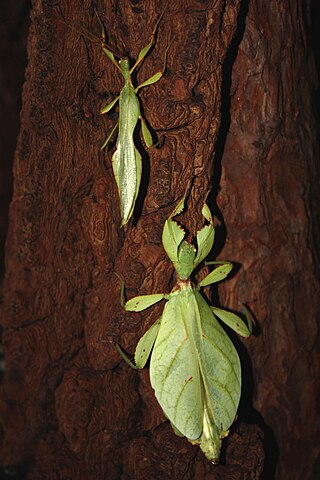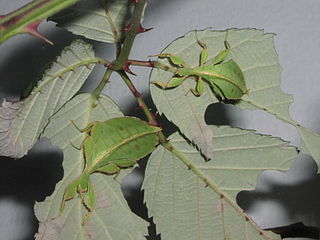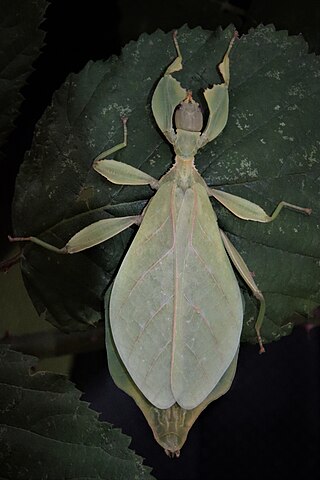
The family Phylliidae contains the extant true leaf insects or walking leaves, which include some of the most remarkably camouflaged leaf mimics (mimesis) in the entire animal kingdom. They occur from South Asia through Southeast Asia to Australia. Earlier sources treat Phylliidae as a much larger taxon, containing genera in what are presently considered to be several different families.

Phyllium is the largest and most widespread genus of leaf insects in the family Phylliidae (Phasmatodea). They can be found in Sundaland, Philippine Islands, Wallacea, and Australasia.

Pulchriphyllium giganteum, commonly known as the Giant Malaysian Leaf insect, is a species of leaf insects described from Malaysia by Hausleithner in 1984 and placed in the genus Pulchriphyllium since 2021. Pulchriphyllium giganteum is the largest species belonging to the genus Pulchriphyllium reaching 105 mm in size. They are found most abundantly in the west Malaysian tropics. The females typically have large elytra that lie edge to edge on the abdomen and tend to lack hind wings making them usually flightless. Males have small elytra and sometimes transparent non-leaflike functional hind wings. Pulchriphyllium giganteum found in the wild tend to be mostly females and the first male of this species was not found until 1994. In captivity, the species has primarily been observed to reproduce through parthenogenesis meaning the females are asexual. The primary reproductive pattern in the wild is unknown. Eggs tend to be brown or black and glossy and resemble seeds. They hatch around 6 months after breeding. Newly hatched young nymphs tend to be wingless and brown or reddish in color. They develop their green color after feeding on leaves. Both the adult and larval stages are phytophagous meaning they feed on plants. The main plant food sources for this species are oak and bramble tree leaves.

Pulchriphyllium bioculatum, Seychelles leaf insect, Javanese leaf insect, or Gray's leaf insect, is a leaf insect of the family Phylliidae native to tropical Asia as well as Madagascar, Mauritius and the Seychelles. It was first described by George Robert Gray in 1832 and was the first phasmid he discovered. Leaf insects have extremely flattened, irregularly shaped bodies, wings, and legs. They are usually about 5–10 cm long. They are called leaf insects because their large, leathery forewings have veins that look similar to the veins on the particular type of leaves they inhabit. Its scientific name bioculatum means "two-eyed" and refers to the two dots located on the abdomen just in this species.
Coprosma elegans is a flowering plant species in the genus Coprosma found in New Guinea.
Cryptophyllium athanysus, is a species of phasmid or stick insect of the genus Cryptophyllium. It is found in Sri Lanka.

Phyllium hausleithneri or Hausleithner's stick insect is a species of phasmid or leaf insect of the genus Phyllium. It is found in peninsular Malaysia, and Sri Lanka.
Nanophyllium brevipenne, is a species of phasmid or leaf insect of the genus Nanophyllium. It is found in New Guinea, and Sri Lanka.
Pseudomicrophyllium geryon is a species of phasmid or leaf insect. It is found in the Philippines, Java, and Sri Lanka.

Phyllium jacobsoni is a species of leaf insect belonging to the family Phylliidae. Its recorded distribution is Java and no subspecies are listed in the Catalogue of Life.

Cryptophyllium westwoodii is a species of leaf insect in the family Phylliidae. It is distributed from southern China, the Andaman islands, Myanmar, Indo-China, Sumatra and the Riouw Archipelago.

Phyllium bilobatum is a species of leaf insect in the family Phylliidae. It is found in the Philippines and Malaysia. This species was first described in 1843 by the English zoologist George Robert Gray, who gave it the name Phyllium bilobatum. It has been assigned to the subgenus Phyllium, which is to be distinguished from the second subgenus Pulchriphyllium, within the genus Phyllium. The holotype is a female from the Philippines, which is kept in the Natural History Museum, London where Gray worked cataloguing insects.

Phyllium letiranti is a species of phasmid or walking leaf of the genus Phyllium. It is only found on the island of Peleng in Indonesia.

Cryptophyllium is a genus of leaf insects in the tribe Phylliini, described in 2021. Its distribution is probably incomplete, but includes southern China, Sri Lanka, Indo-China, Malesia and western Pacific islands.

Phyllium mabantai is a species of leaf insect in the family Phylliidae. It is endemic to the Philippines.

Phyllium philippinicum is a species of leaf insect in the family Phylliidae. It is endemic to the Philippines.

Phyllium gantungense is a species of insect in the family Phylliidae. It is endemic to the Philippines.

Phyllium monteithi is a species of phasmatodea in the family Phylliidae. P. monteithi is found in tropical Queensland in Australia. The type specimen was collected from Mount Lewis, near Julatten. Reproduction occurs through parthenogenesis and conventional mating. P. monteithi is known to feed on leaves from the myrtle family however, another well known food plant is Szygium Australe. Males are between 61 and 64 mm in length, females to 76 mm. This species is popular as a pet in Australia and Europe.

Nanophyllium australianum, also known as the Queensland leaf insect, is a species of leaf insect found in the Iron Range in Northern Queensland.















